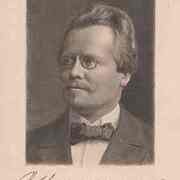Otto Julius Bierbaum (1865–1910)
Auteur van Samalio Pardulus
Over de Auteur
Fotografie: Photo © ÖNB/Wien
Reeksen
Werken van Otto Julius Bierbaum
Die Freiersfahrten und Freiersmeinungen des weiberfeindlichen Herrn Pankrazius Graunzer, der Schönen Wissenschaften… 4 exemplaren
Sonderbare Geschichten 3 exemplaren
Der Neubestellte Irrgarten der Liebe: Um Etliche Gaenge und Lauben Vermehrt Verliebte, Launenhafte, Moralische und… (2017) 3 exemplaren
Aus dem Irrgarten der Liebe verliebte, launenhafte, moralische und andere Lieder und Gedichte 3 exemplaren
Gesammelte Werke, sechster Band: Prinz Kuckuck: Leben, Taten, Meinungen und Höllenfahrt eines Wollüstlings (1980) 3 exemplaren
Gugeline. Ein Bühnenspiel in 5 Aufz. von Otto Julius Bierbaum. Mit Buchschmuck v. E. R. Weiss. Als 1.… 2 exemplaren
Der Bräutigam wider Willen : Komödie in 4 Aufzügen. Nach einer Erzählung Dostojewskis 2 exemplaren
Briefe an Gemma 1 exemplaar
Franz Stuck, über hundert Reproductionen nach Gemälden und plastischen Werken, Handzeichnungen und Studien 1 exemplaar
Hans Thoma 1 exemplaar
Ausgewählte Gedichte 1 exemplaar
Hamburger Lesehefte : Otto Julius Bierbaum : Zäpfel Kerns Abenteuer : Ein Märchen (1986) — Text — 1 exemplaar
Die drolligen Geschichten des Herrn Balzac 1 exemplaar
LibriVox Adventskalender 2016 1 exemplaar
Gesammelte Werke, siebter Band: Reisegeschichten 1 exemplaar
Zur Kurzweil heitere Geschichten 1 exemplaar
Hans Wurst und andere Grotesken 1 exemplaar
Biographie 1 exemplaar
Das Reimkarussell 1 exemplaar
Das höllische Automobil : Novellen 1 exemplaar
Gesammelte Werke 1 exemplaar
Die Haare der heiligen Fringilla und andere Geschichten. Sechstes und siebentes Tausend. 1 exemplaar
Zwei Münchener Faschingsspiele 1 exemplaar
Maultrommel und Flöte : neue Verse 1 exemplaar
Aus beiden Lagern : Otto Julius Bierbaum ; Betrachtungen, Karakteristiken u. Stimmungen aus d. ersten… 1 exemplaar
Zwei Stilpe-Komödien 1 exemplaar
Das schöne Mädchen von Bao 1 exemplaar
Gerelateerde werken
Der Roman der Zwölf : ein literarischer Scherz aus dem Jahre 1909 (1992) — Medewerker — 10 exemplaren
50 seltsame Geschichten — Medewerker — 1 exemplaar
Velhagen und Klasings Almanach 1909 — Medewerker — 1 exemplaar
Tagged
Algemene kennis
- Pseudoniemen en naamsvarianten
- MÖBIUS, Martin
BIERBAUM, Otto Julius - Geboortedatum
- 1865-06-28
- Overlijdensdatum
- 1910-02-01
- Geslacht
- male
- Nationaliteit
- Germany
- Geboorteplaats
- Grünberg, Schlesien, Deutsches Reich
- Plaats van overlijden
- Dresden, Sachsen, Deutschland
- Woonplaatsen
- Dresden, Sachsen, Deutschland
Leipzig, Sachsen, Deutschland
München, Bayern, Deutschland - Beroepen
- journalist
editor
writer
librettist
Leden
Discussies
Samalio Pardulus in The Chapel of the Abyss (juli 2021)
Besprekingen
Misschien vindt je deze ook leuk
Gerelateerde auteurs
Statistieken
- Werken
- 58
- Ook door
- 4
- Leden
- 156
- Populariteit
- #134,405
- Waardering
- 3.9
- Besprekingen
- 2
- ISBNs
- 28
- Talen
- 2
- Favoriet
- 1




Samalio Pardulus was a painter in medieval Albania. Rather than documenting him from an omniscient third-person narrator as in À rebours or through the medium of his own written journals as in Fantazius Mallare, Bierbaum places two narrative frames between the reader and the character. First, there is a "staid philistine" Italian painter Messer Giacomo, imported to instruct Samalio, whose journals form the purported documentary basis of the story in the form of extensive quotations. Then there is the anonymous archivist who introduces and comments on Giacomo's account. Through the course of the book, this archivist outside of the quotes retreats to invisibility, having left behind only a suitable readerly suspicion regarding Giacomo's perceptiveness.
Samalio himself is ugly, talented, and blasphemous. He is concerned with making objects out of his imaginings, and to the extent that this work tends to horrify his pious teacher, his explanations of it become theological, deprecating a cosmic demiurge and exalting his own "godly pleasure in the grotesque" (14). Beyond his inchoate gnosticism and solipsism, Samalio defines himself with incestuous ambitions for his beautiful sister. These eventuate in a numinous domestic apocalypse. The interrelation of the principal characters--Samalio, his sister Maria Bianca, their father the Count, an unnamed watchman, and Messer Giacomo--eventually becomes so outre that it awoke in me suspicions of allegory.
This first English edition is illustrated with many full-page charcoal drawings by Alfred Kubin that appeared in the original 1911 German edition. Some of these depict Samalio's paintings, but most are scenes from the novel.… (meer)